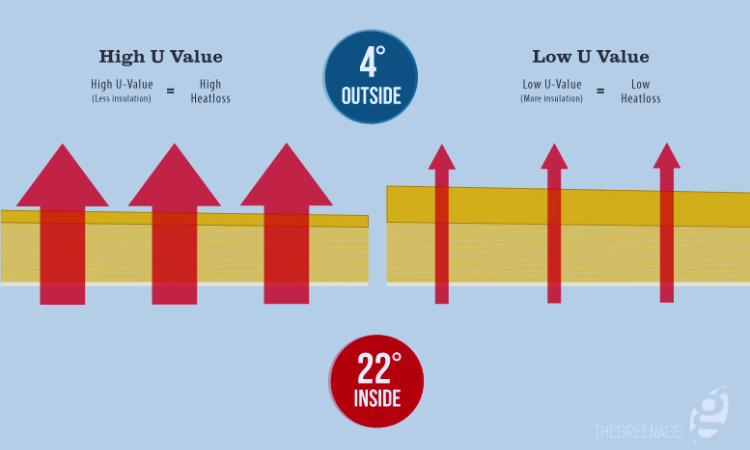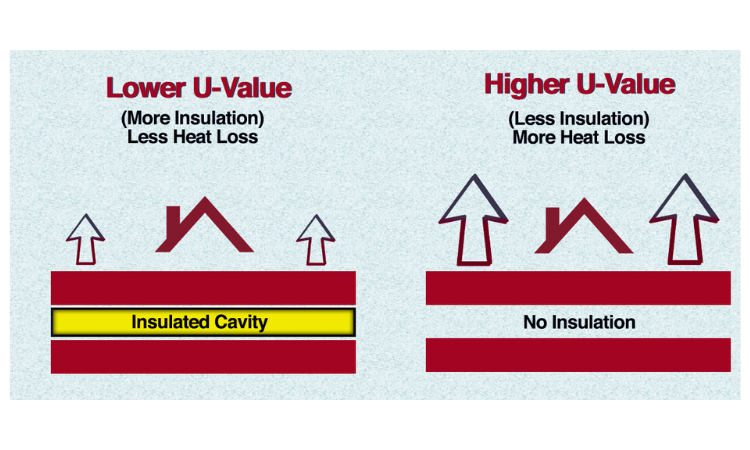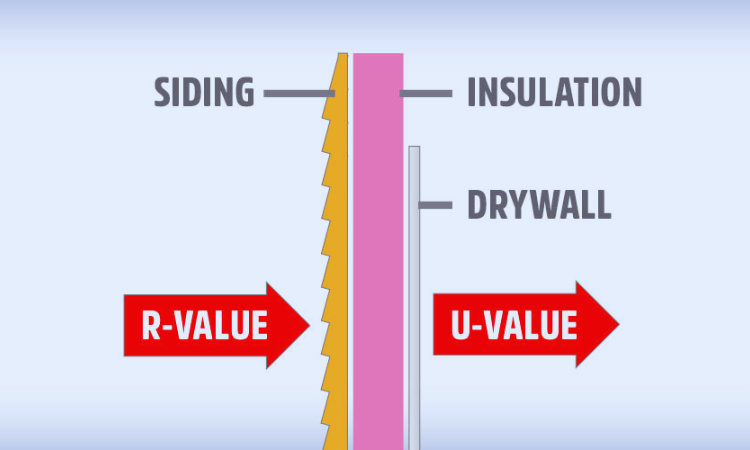Categories
New Blog
R Value vs U Value: What's the Difference and Why It Matters to Your Home
August 27 , 2024Energy efficiency is far from a buzzword as it is essential in any contemporary home design. It can have big implications on how comfortable your house warms or cools, and what you pay monthly for electricity. When discussing whether your home is well insulated, these are two vital terms you will probably hear being used to explain it.
But what does that mean, and why should you care? These figures are important because they help evaluate how well your home can insulate and deliver energy performance. Knowing the difference between R and U values can help you decide on home insulation.
What is R-Value?
The resistance to heat flow of an insulating material is called the R-value. The higher the R-value, the better the insulated material to keep your home toasty and warm in winter and nice and cool during warmer summer months. R-value is important in assessing several materials, such as fiberglass insulation or foam, that are conducive to ensuring walls, attics, and floors.
How to measure the R value

We calculate the R-value with thermal conductivity, i.e., the thickness of insulation divided by its Thermal Conductivity. Insulation thicknesses are measured in inches, and thermal conductivity is measured by how much heat is transferred.
Why R-values matter to homeowners
An R-value is obtained by measuring the temperature difference across an insulating material. We can then find how much heat (Heat Flux) it takes to reach a certain point and the thickness of the particular material. Many variables affect the R-value, including a given layer's material, density, and thickness. Thicker materials, such as sculpted fabric for insulation, tend to possess higher R values.
Homeowners need to know that an R-value is probably the most important factor in determining how well their home retains heat. Theoretically, a better-insulated house with high R Values would cost less to heat and cool. Therefore, it is important to choose insulation materials that ensure you do not spend more money on heating than required, depending upon your climate needs and home configuration options.
Examples of R-values for different materials
R Values vary from One Material to Another. Fiberglass insulation, for example, typically has an R-value of around 3.0-3.5 per inch, whereas spray foam insulation can get as high as a whopping 6.5 per inch! Windows and doors also have R Values, although generally smaller than those of insulation materials.
What is U Value?

How to measure the U value
Calculation of the U Value is the measurement to determine how much heat transfers through a material per unit of time. The formula for the U Value is:
U Value=1 R Value\text{U Value} = \frac{1}{\text{R Value}}U Value=R Value1
This shows that the U Value is the reciprocal of the R-value. U Value considers the full assembly of building materials (including gaps and joints between any layers), offering an accurate evaluation of a given component.
Importance of U-value in assessing thermal performance
It is especially important when determining the thermal performance of windows, doors, and other buildings where heat transfer critically affects aesthetics or comfort. A lower U Value results in this part of a building element being more resilient when it comes to holding the heat inside during cold months and outside during warmer days. Thus it ensures optimal living conditions indoors.
Examples of U-values for various building components
For example, a good double-glazed window might have a U Value of about 1.6 W/m²K, whereas triple-glazing could be as low as 0.8 W/m²K.
R value vs U value: What's the Difference
Learn all you need to know about R-Value vs. U-Value and how they can help you insulate your home. However, thermal impedance and resistance are used for different reasons despite both relating to a product's thermal performance.
Fundamental difference
The R-Value measures resistance to heat flow. Thus, the higher the R-value, the better the insulating material is. A low U Value is desirable because it reflects the speed at which heat travels through an object. The R-value measures how well something insulates, while the U-value tells how much heat the building component loses.
When to use R-values vs U-values
You should consider the R-value when comparing insulation materials for your walls, attic, or floors, as you want to ensure that the material provides maximum resistance to heat flow. U Value is more useful for windows, doors, and similar products you want to keep the heat in your building.
For instance, if you select insulating material for your space and wish to ensure the most effective resistance. In simpler terms, it keeps the building cold in summer and warm during winter. In window selection, U Value matters most as it explains the amount of heat transfer that will occur in window assembly. R-value and U-value are equally important for the respective parts of a home, and they should be installed first to help improve energy efficiency instead.
Why R values and U values are important for your home
R-value and U-value are two of the most important aspects of how energy-efficient your home is. This directly impacts heating and cooling costs and whether it can be considered green.
Impact on Heating and Cooling Costs
Higher R Values and lower U Values are better insulators. They keep the heat in, so your home uses less energy for heating/cooling. It results in lower utility bills and less of a carbon footprint, which means that your home is greener as well.
Role in Home Comfort and Sustainability
A well-insulated house is more comfortable and energy efficient. Proper insulation means your home will be warm in winter and cool in summer without much heating or cooling systems. Additionally, homes with better insulation are more sustainable as they reduce energy demand.
Role in Sustainable Building Practices
Both R Value and U Value aspects should be incorporated for a sustainable building practice for a sustainable building practice when designing or renovating your house. Choosing materials and components with optimum R and U Values create an energy-efficient, comfortable, ecologically responsible household.

Factors to Consider When Selecting Insulation Materials with the Right R-Value:
Choose insulation with an R-value suitable for your climate. Higher values are better for colder areas. Think about the thickness of the material as well as its moisture resistance ability and air tightness. Balance the cost of insulating against the performance required for thermal efficiency goals.
Choose Windows and Doors with Optimal U Value:
Consider windows and doors having low U Values, as this would reduce heat loss, especially in colder regions. A larger building may be more advantaged by lower U values in windows and doors. Ensure that the products meet or surpass the local energy efficiency standards.
Importance of Considering Climate and Regional Energy Codes:
Obeying regional energy codes is important because they usually specify minimum R values and maximum U values based on local climatic conditions. These codes make sure that your home is both comfortable and affordable.
Tips for homeowners to increase the R value and U value of their existing home:
Boost your home's R-value by adding extra insulation to attics, walls, and floors. Reduce heat transfer by upgrading to energy-saving windows and doors, thus lowering u value. Check regularly for gaps around windows and doors, sealing them when necessary to maintain thermal performance at its peak.
Common Myths About R Value and U Value
Several popular misconceptions about U-value and R-value are responsible for poor insulation decisions in homes.
Myth 1: Higher R-Value Always Means Better Insulation
Although high R-values generally indicate better insulation. It is not the only factor to consider. In addition to other factors, good insulation also depends on correct installation and resilience to moisture and air infiltration.
Myth 2: U Value Doesn't Matter as Much as R-Value
Both U-value and R-value matter, but they have different roles. For example, components like doors and windows need low U-values since heat loss is a major concern.
Myth 3: R Value and U Value Are Only Important in Cold Climates
R-value or u-value matters in all climates. For instance, if you live in hotter regions, proper insulation will keep your home cool, thus reducing dependence on air conditioning services.
About R Value and U Value of FAQs
How can I improve the U-value of my existing windows?
You can increase the U-Value of your present windows by adding storm windows, using thermal curtains, or applying window films that reduce heat transfer.
Is it worth replacing old windows to get a better U-value?
Yes, replacing old windows with newer, more energy-efficient models can minimize heat loss, enhance comfort, and lower energy expenses.
How do building codes affect R Value and U Value requirements?
Building codes usually specify minimum R Values and maximum U Values in diverse climatic zones to ensure the appropriateness of a house's energy efficiency.
What is R-value in structural engineering?
In structural engineering, R-value refers to the ability of insulation to resist heat flow, which is critical for maintaining structural integrity and energy efficiency.
What are the U values for windows and doors?
U-values for doors and windows differ depending on their material types, construction, etc. Normally, an energy-efficient model would have lower U-values, indicating better thermal performance.
Conclusion
This article provides a comparative analysis to show that R-values and U-values are critical to improving the energy efficiency of your home.
To Sum Up, While the R-value measures a material's resistance to heat flow, the U-value measures how fast heat passes through building components. Both are important aspects of home insulation, and they play a key role in cutting down on utility costs, improving comfort levels, and promoting environmental sustainability.
Therefore, it is important to consider R-value and U-value factors when shopping for windows for your home .
If you still have questions about this, you can contact us and we will be happy to help you. Hotian Windows is a professional and reliable window and door company with experience in window and door manufacturing. We also offer other comprehensive services such as bespoke windows and doors, window and door solutions, window and door design and after sales services to name a few.